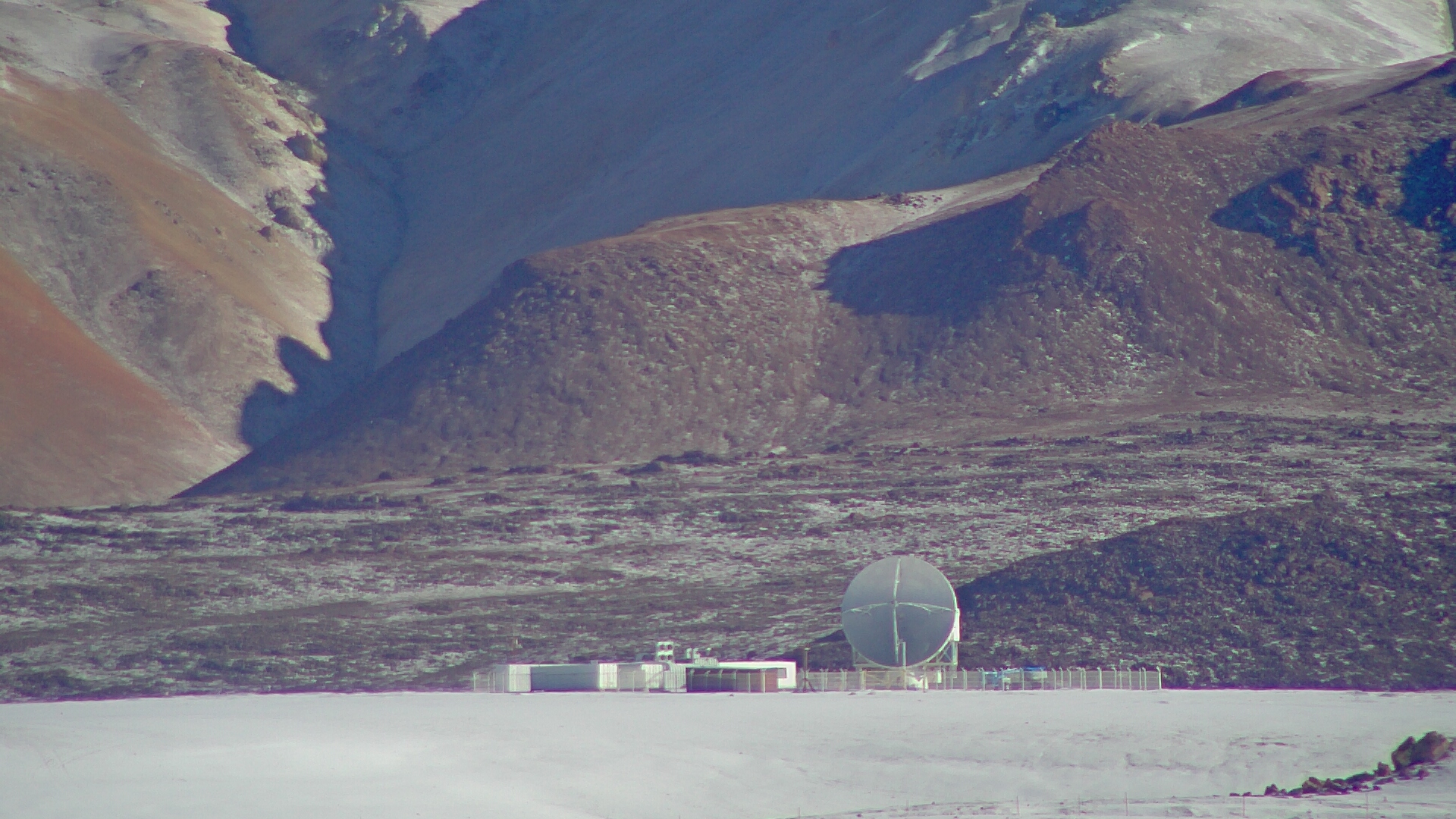APEX
Neue Maßstäbe in der Submillimeterastronomie
Das Atacama Pathfinder Experiment (APEX) befindet sich an einem der höchstgelegenen Observatoriumsstandorte überhaupt: auf der Hochebene Chajnantor in der Atacama-Region Chiles auf 5100 Metern über dem Meeresspiegel.
APEX ist ein Teleskop für den Millimeter- und Submillimeterbereich an der Grenze zwischen Infrarotlicht und Radiowellen. Seine Antennenschüssel hat einen Durchmesser von 12 Metern. Submillimeterastronomie eröffnet Einblicke in die kalten und staubigen Regionen unserer kosmischen Nachbarschaft sowie in sehr ferne Regionen des Universums. Allerdings genügen schon geringe Mengen Wasserdampf in der Erdatmosphäre, um Licht dieser Wellenlänge, das die Erde aus dem Weltraum erreicht, zu absorbieren. Daher ist Chajnantor ein idealer Standort für solch ein Teleskop: Es gehört zu den trockensten Regionen der Erde und liegt 750 Meter höher als die Observatorien auf dem Mauna Kea in Hawaii und rund 2400 Meter höher als das Very Large Telescope auf dem Paranal.
LIVE-Webcam
LIVE-Bild von APEX ()
Das Chajnantor-Plateau virtuell besichtigen
|
Klicken Sie auf das Bild um eine Virtuelle Tour auf der Hochebene Chajnantor zu unternehmen |
APEX ist das größte Submillimeter-Teleskop auf der Südhalbkugel. Eines der wichtigsten dort installierten Beobachtungsinstrumente ist LABOCA, die Large APEX Bolometer Camera. Sie besteht aus einer Anordnung extrem empfindlicher Thermometer – so genanntes Bolometer – mit deren Hilfe sich die Submillimeter-Strahlung nachweisen lässt und ist mit fast 300 Pixeln weltweit die größte Kamera ihrer Art. Um die winzigen Temperaturunterschiede nachweisen zu können, die der Einfall der schwachen Submillimeterstrahlung bewirkt, muss jedes der Thermometer auf 0,3 Grad über dem absoluten Nullpunkt gekühlt werden – beachtliche –272,85°C. LABOCAs hohe Empfindlichkeit, kombiniert mit einem vergleichsweise großen Gesichtsfeld (entsprechend einem Drittel des Durchmessers des Vollmondes) machen diese Kamera zu einem wertvollen Werkzeug zur Erforschung des Submillimeter–Universums.
APEX hat ALMA, dem Atacama Large Millimeter(submillimeter Array, den Weg bereitet. ALMA ist ein neuartiger Teleskopverbund, das die ESO derzeit zusammen mit internationalen Partnern am Standort Chajnantor betreibt. APEX basiert auf dem Prototypen einer Antenne für ALMA und sucht nach Beobachtungszielen, die ALMA detailliert untersuchen wird.
APEX war früher ein Gemeinschaftsprojekt, an dem das Max–Planck–Institut für Radioastronomie (MPIfR, 55%), das schwedische Onsala Space Observatory (OSO, 13%) und die ESO (32%) beteiligt waren. Heute ist es ein reines MPIfR-Projekt, wird aber von der ESO betrieben.
Wissenschaft mit APEX
 Der Submillimeterbereich ist eine aus astronomischer Sicht vergleichsweise wenig gut erkundete Region des elektromagnetischen Spektrums. Wer bei diesen Wellenlängen in den Kosmos schaut, nimmt Strukturen wahr, die für sichtbares oder Infrarotlicht verborgen bleiben. Hier offenbart sich das "kalte Universum": Strahlung dieser Art senden insbesondere die ausgedehnten kalten Molekülwolken aus, die sich im interstellaren Raum befinden und deren Temperaturen nur wenige Zehntel Grad über dem absoluten Nullpunkt liegen. Im Inneren dieser Gas- und Staubwolken entstehen neue Sterne – und die Astronomen nutzen den Submillimeterbereich, um die physikalischen und chemischen Eigenschaften der Wolken zu erkunden. Im Bereich des sichtbaren Lichts betrachtet sind die betreffenden Gebiete des Universums aufgrund des hohen Staubgehalts in der Regel undurchsichtig. Im Millimeter- und Submillimeterlicht dagegen werden hell leuchtende Strukturen sichtbar. Auch die entferntesten und jüngsten Galaxien, die sich von der Erde aus beobachten lassen, sind vornehmlich in diesem Bereich des Spektrums sichtbar – nicht, weil sie besonders kalt wären, sondern weil die Wellenlängen des Lichtes, das sie aussenden, durch die Expansion des Universums gedehnt worden ist, und ihre Strahlung nun im Submillimeter- oder Millimeterbereich die Erde erreicht.
Der Submillimeterbereich ist eine aus astronomischer Sicht vergleichsweise wenig gut erkundete Region des elektromagnetischen Spektrums. Wer bei diesen Wellenlängen in den Kosmos schaut, nimmt Strukturen wahr, die für sichtbares oder Infrarotlicht verborgen bleiben. Hier offenbart sich das "kalte Universum": Strahlung dieser Art senden insbesondere die ausgedehnten kalten Molekülwolken aus, die sich im interstellaren Raum befinden und deren Temperaturen nur wenige Zehntel Grad über dem absoluten Nullpunkt liegen. Im Inneren dieser Gas- und Staubwolken entstehen neue Sterne – und die Astronomen nutzen den Submillimeterbereich, um die physikalischen und chemischen Eigenschaften der Wolken zu erkunden. Im Bereich des sichtbaren Lichts betrachtet sind die betreffenden Gebiete des Universums aufgrund des hohen Staubgehalts in der Regel undurchsichtig. Im Millimeter- und Submillimeterlicht dagegen werden hell leuchtende Strukturen sichtbar. Auch die entferntesten und jüngsten Galaxien, die sich von der Erde aus beobachten lassen, sind vornehmlich in diesem Bereich des Spektrums sichtbar – nicht, weil sie besonders kalt wären, sondern weil die Wellenlängen des Lichtes, das sie aussenden, durch die Expansion des Universums gedehnt worden ist, und ihre Strahlung nun im Submillimeter- oder Millimeterbereich die Erde erreicht.
Wissenschaftliche Ziele
Astrochemie, kaltes Universum
Weitere Informationen zur Wissenschaft mit APEX
- Wissenschaft mit ESO-Teleskopen
- Die Top 10 astronomischen Entdeckungen der ESO, auf APEX-Daten basiert Nr. 7 (auch als Präsentation verfügbar)
Weitere Informationen zu APEX
- Zahlen und Fakten finden Sie bei den häufig gestellten Fragen
- Weitere Bilder und Videos sind im Multimediaarchiv der ESO abrufbar
- Weitere Informationen über das Teleskop finden Sie im APEX-Handout als PDF
- Für Wissenschaftler: Weitergehende Informationen finden Sie auf der APEX-Webseite
APEX-Zeitraffer
APEX-Trailer
Laden Sie diesen Trailer in verschiedenen Formaten aus dem Videoarchiv herunter
APEX
|
APEX bei Google Maps



